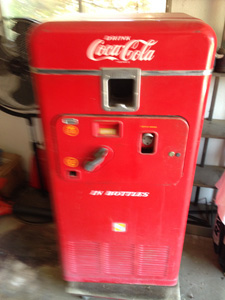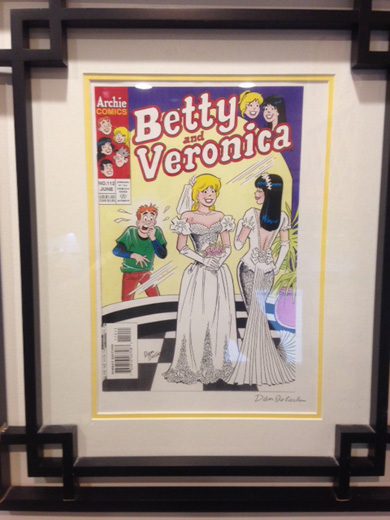 |
|
|||
 |
 |
|||
RINKER ON COLLECTIBLES — Column #1477 Copyright © Harry Rinker, LLC 2015 Questions
and Answers
ANSWER: You have a Vendorlator Model 33 vending machine. For a detailed history, see: http://www.vintagevending.com/the-vendorlator-manufacturing-co-a-soda-machine-company. I found an identical, unrestored example of a 1950s Coca-Cola Vendorlator Model 33 listed on eBay with a "Buy It Now" price of $1,800.00. Professionally restored machines are priced in the $2,500.00 to $4,000.00 range. Now that I have your hopes up, it is time to bring you down to earth. The market is saturated with Model 33 vending machines. Any serious Coke collector who wants one has one. The $1,800.00 price for an unrestored machine is unrealistic. The principal buyers for these machines are individuals who want to use them as a decorative/conversation accessory. In terms of a nostalgia purchase, the generation that grew up with the machine is in their 60s, an age when individuals are thinking more about selling than buying. I recommend taking any offer over $500.00. In terms of selling the Vendorlator Model 33 vending machine, my first thought is Craigslist. These buyers are local and know they are responsible for picking up and removing the machine. List it at best offer above $500.00. Second, see if there is a local antiques/collectibles mall or shop that will take it on consignment. Today, the usual consignment fee is between 35 and 50 percent. You also will be responsible for moving it to the mall. In a consignment shop, it might bring $750 to $1,000 but is likely to sit a spell at that price. Third, donate it to a local historical group or charity. Make certain the charity is a 501(c)3 organization. Get a letter of gift on the group's letterhead. You can claim up to $4,999.00 on your taxes without an appraisal. My recommendation would be between $1,500.00 and $2,000.00. The amount you get back depends on your tax bracket. If your tax bracket is 20 percent, then $300.00 to $400.00 If you are in the 30 percent bracket, then $450.00 to $600.00 There is less work if you do this, and you might realize more than if you sold it. The only thing you have to be careful about is if the organization sells it within a year of your donation and the vending machine realized less than you claimed. Theoretically, the IRS could ask you to return the tax on the difference between what you claimed it was worth and the sold price. Fourth, offer it to friends. If someone visits and says "I would love to own that,” respond with “do I have a deal for you.” QUESTION: I own a copy of “The Best of Playboy,” authored by Hugh Hefner, published for HMH Publishing by The Waldorf Publishing Corporation (222 Fourth Avenue, New York, and copyrighted 1954. Inside it states: “Here in one volume is the best material from the first issues of Playboy.” The book is hardcover. There is a yellow paper cover over the hardbound cover that is in fair condition. The cost in 1954 was $3.75. The book contains jokes, cartoons, and other material. The book was given to my grandfather, a prim and proper man who worked at a bank in Hazelton, Pennsylvania, by his boss as a gag gift. What is the value of my book? – DK, Nescopeck, PA, Email Question ANSWER: The first issue of “Playboy,” featuring a centerfold of Marilyn Monroe’s Golden Dream photograph, was published in December 1953. The rest is history. [Historical Note: Hefner was not certain his magazine would be a success. Hence, the first issue contains no date. Hefner did not publish a March 1955 issue, the only month since the December 1953 issue that “Playboy” failed to appear.] Hefner realized the value of compiling articles, photographic articles, jokes, cartoons, and other material from “Playboy” into “Best of” and/or annual publications from the beginning. The practice continued into the early 1970s. The 1954 “The Best from Playboy” has a paper dust jacket featuring the head of a bunny whose eye reflects the legs of an attractive young woman. The dust jack usually does not survive. A listing on www.rarelibrary.com for the volume without the dust jacket has an asking price of $139.95. The description notes the book has an oversize format, is 160 pages in length, and features a hard front cover with a blue cloth with the “Playboy” in pajamas on the left over tan boards. Beware of the first price you find on the internet. A check of www.abebooks.com showed a copy in fine condition with a dust jacket in very good condition listed at $75.00. The asking price for examples without the dust jacket ranged from $8.00 to $40.00. It pays to comparison shop when buying anything on the internet, including antiques and collectibles. Your 1954 “The Best of Playboy” with its dust jacket has a value between $45.00 and $60.00. QUESTION: I have a blueberry farm. Today, thanks to advanced technology, most blueberries are picked by machine. I have a large number of old metal blueberry rakes similar in style to cranberry rakes. Do they have any collecting value? – B, Newport, ME ANSWER: While I have encountered numerous cranberry rakes in the past, I was not familiar with blueberry rakes. I enjoyed researching the topic. I was surprised at the wide variety of historical blueberry rakes. There is enough variety to create a meaningful collection. However, most older examples are purchased as “hang on the wall” decorations. The older blueberry rakes appear to be made of wood or galvanized tin. The Hubbard Rake Co. of Jonesport, ME, founded in 1990 by Harold “Ike” Hubbard, started making aluminum rakes in 1990. Racks vary in size from 12 tongs to 110 tongs. The company’s website www.hubbardrakes.com notes: “Items available from the Hubbard Rake Company include: Hand Held Rakes for Harvesting Blueberries (Low and High Bush), Cranberries, Huckleberries, herbs, seaglass and the horsestall rake.” eBay.com contains listings for several dozen older blueberry rakes. Prices range from $15.50 (tin) to $150.00 (early 20th century wood). The average price is around $35.00. This is a “cheaper than new” price. New blueberry rakes start around $40.00 and extend upward to $85.00. If you sell blueberries at a roadside stand as part of your business operations, offer your blueberry rakes for $35.00, more if the tong count is high. Otherwise, list your blueberry rakes on Craigslist. New England is the most obvious market. Living in western Michigan, I am in the heart of blueberry country. The next time I stop at one of the farm stands, I am going to ask about their harvesting methods and what do they do with their old hand harvesting tools. FOLLOW-UP: RS of Halesite, NY, whose question about a signed Dan DeCarlo, Archie Comics cartoon I answered in “Rinker on Collectibles” Column 1475, sent me a picture of the signed item he had. As I thought, the comic image was not an “Archie” title but an enlargement of the No. 112 “Betty and Veronica” comic. This 1987 title sells on the secondary market for under $2.00. While there is a strong secondary market for autographed DeCarlo comic page art, a commercial edition item such as this print has limited market appeal. Now that I have seen a photograph of the piece, I estimate its secondary market value in the $75.00 to $90.00 range. Offering it for sale at a comic convention is the best method to dispose of the piece. It will not do well at auction.
Harry L. Rinker welcomes questions from readers about
collectibles, those mass-produced items from the twentieth and twenty-first centuries.
Selected letters will be answered in this column.
Harry cannot provide personal answers.
Photos and other material submitted cannot be
returned.
Send your questions to: Rinker on Collectibles, 5955 Mill
Point Court SE, Kentwood, MI 49512.
You also can e-mail your questions to
harrylrinker@aol.com.
Only e-mails containing a full name and mailing address
will be considered.
You can listen
and participate in
WHATCHA GOT?, Harry’s
antiques and collectibles radio call-in show, on Sunday mornings between 8:00 AM
and 10:00 AM Eastern Time.
If you
cannot find it on a station in your area,
WHATCHA GOT?
streams live on the Internet at www.gcnlive.com.
SELL, KEEP OR TOSS?: HOW TO DOWNSIZE A HOME,
SETTLE AN ESTATE, AND APPRAISE PERSONAL PROPERTY
(House of Collectibles, an imprint of Random House Information Group, $17.99),
Harry’s latest book, is available at your favorite bookstore and via
www.harryrinker.com.
|
||||
 QUESTION: I have a 1950s Coca-Cola vending machine in working condition. I do not know the model, although a logo on the side reads “VMC.” The top of the red colored cabinet reads “DRINK / COCA-COLA.” There is square opening beneath through which the bottle is dispensed. Once the correct change has been inserted, the user pulls down on a handle. I have no use for the machine and would like to sell it. What advice do you have? – TR, Visalia, CA, Email Questions
QUESTION: I have a 1950s Coca-Cola vending machine in working condition. I do not know the model, although a logo on the side reads “VMC.” The top of the red colored cabinet reads “DRINK / COCA-COLA.” There is square opening beneath through which the bottle is dispensed. Once the correct change has been inserted, the user pulls down on a handle. I have no use for the machine and would like to sell it. What advice do you have? – TR, Visalia, CA, Email Questions